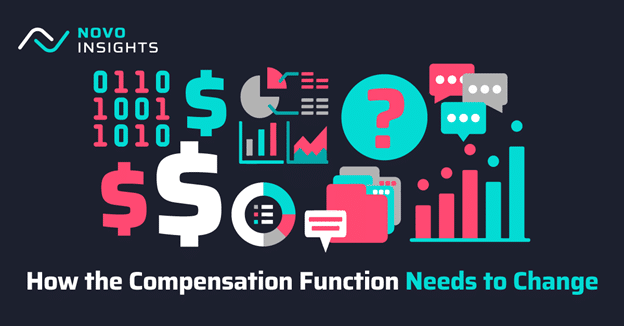How the Compensation Function Needs to Change
By Paul Reiman
Founder and Managing Partner
NovoInsights
News flash: the world of compensation has changed dramatically.
Has your approach to compensation changed as well?
Compensation plays an important role in why talent chooses to join an organization, stay with that organization, and remain engaged in producing quality work. Compensation professionals, then, have a business-critical role to design, implement, and sustain compensation programs that meet these objectives while also managing the level of investment required.
This hasn’t changed. But the context has.
Surrounding the role of compensation are a number of changes in the general environment that affect compensation teams. These changes change the work a compensation team is required to do in order to deliver the objectives of the compensation program.
The Changes Driving Evolution
Let’s highlight a few of the key changes.
1. Pay Equity
While there has been federal and state legislation mandating equal pay for more than 50 years, the focus on gaps in pay has increased materially in the past decade. A new category of HR tech company has developed to help organizations understand the fairness of pay practices, looking to eliminate discriminatory acts and minimize adverse impact in other pay decisions. A broader focus on corporate ESG has created new disclosure expectations.
The talent market, and notably under-represented talent, expects to be paid fairly – and expects their organization to make and deliver upon a pay equity commitment. This increases the prominence of an organization’s pay strategy, processes, and tactical decisions.
2. Pay Transparency
Driven in part by the focus on pay equity, there is increasing pressure for organizations to be more transparent about pay. New legislation has been implemented to mandate certain elements of pay disclosure, and workers ask more and more for insights into how their compensation is determined.
Pay transparency requires compensation functions to drive more consistency in decision, while requiring implementation of investment and/or communication to address the impact of a lack of historical transparency.
3. Public Information Availability
Workers have ready access to information about rates of pay. Glassdoor and LinkedIn will use their data to report on where a worker falls in the market. Sites like Levels and Blind provide a confidential place for sharing rates of pay within and across companies.
As a result, workers have a “known” market rate – regardless of what the Compensation function designates as a market rate of pay.
4. Work Location Flexibility
The COVID-19 pandemic has accelerated a general trend toward working away from a traditional office, and notably accelerated the movement of certain professional roles away from higher-cost urban centers. This changes the market in which an organization is competing for talent, which requires a new approach to defining fair rates of pay within a more flexible market.
5. Technical Capability
Many compensation “best practices” have their roots in the 1980s – when creating a salary structure was in part required to simply make sure multiple locations were following a set of corporate principles, so ranges were printed on cards to set expectations. As the speed of business has increased and communications capabilities improved, compensation structure and process has become less about consistency and compliance. The ability for the organization to collect, store, analyze, and communicate data has created new expectations from corporate leaders and individual managers.
New Expectations Require New Practices
These shifts in the compensation landscape have raised expectations for the compensation function – no doubt. In far too many cases, though, compensation functions have been slow to implement new ways of working to combat these general trends.
Here are five ways that Compensation functions needs to evolve to better address these challenges.
From Answers to Solutions
As organizational context becomes ever more defined by the interplay between business strategy, culture, and social cause, we have to approach problems assuming the answer will be an innovation rather than being prepared to implement a past solution. What works at Company A won’t work the same way at Company B, because those companies are probably more different than similar. As compensation practitioners, we’ve typically liked to focus on other practices within our industry, but we forget about how local market dynamics or distinct employee experiences shape how reward solutions actually make an impact.
As compensation professionals, we need to become experts in solving problems, not providing peer group data and “best practices.” We need to question our assumptions, challenge existing practices, and press for change. We need to become experts at designing experiments, evaluating evidence, and ensuring our solutions drive impact.
From Benchmarking to Valuing Productivity
With flexible roles, gig economies, and pivotally productive roles like engineers, what others pay on average or the top 25% is less important than how to value the productivity of effort and results. We need to own the conversation about sourcing skills and output, knowing the different forms that can take. Our unit of analysis today is “the employee.” In the future it needs to become “the work.”
This is one area where the compensation technology/consulting ecosystem needs to step up, too. The world of surveys has existed because the business problem has been framed as “market pricing.” But the real business problem is estimating the cost to acquire skills and productivity to execute business processes or create customer value. We need tools that think this way. When a seasoned software engineer chooses to “retire” but still freelance via Upwork at $60 per hour, she is still part of the market that will go completely uncaptured by traditional measurement. The compensation function needs to understand this dynamic and guide the conversation.
From Job Evaluation to Solution Creation
Advances in data tech show that we can be more precise and unbiased in terms of benchmarking. There’s a method to LinkedIn suggesting my market value to me… Amazon recognizing that my buying a certain two books means they’ll be able to entice me to buy the third… or Google serving up an ad for a data science degree as soon as I search the word tuition. Matching algorithms are among the most mature in the machine learning space. So the day is not far off when the machines look at descriptions of your roles and data available about the people in those roles, and smashes it up against the same from hundreds of companies. The resulting benchmark will be as accurate and likely less biased than a trained compensation professional. Solutions like this are in the works – the robots are being trained!
This may scare many compensation professionals, as it suggests the compensation analyst job will go away – and maybe it will as we know it today. However, we need to see this as an opportunity to spend less time figuring out the value of a role and more time identifying how to use that determination of value. What’s the right approach to job offers? How do we build a bridge toward a new transparency strategy? What new forms of enablement can we create for managers?
From Structures and Processes to Stories and Conversations.
In an era of transparency and progressive expectations, traditional salary management is becoming pointless. Employees don’t care that the range midpoint is $X when they see on Glassdoor that their value is $X+Y. Managers can’t articulate why a 4% raise is good, let alone keep someone with a 2% raise fully engaged in that conversation. We force difficult conversations upon managers, without a clear story to tell. One manager recently described the annual compensation review process as “my annual opportunity to disappoint most of my team.”
What needs to matter more is how career progression and development align with pay opportunity progression, weaving a holistic story of their employee experience. In an era of pay transparency, we need to take the focus from “where do I stand” to “where am I headed.” The compensation function needs to challenge our assumptions and discover ways to deliver career moments that reward progression and contribution, rather than stress-filled annual salary conversations.
From Bonuses to Incentives
One consulting firm has tracked the rise of variable pay spending over the years, and there is no doubt that more companies are using variable pay and pushing money into variable awards. Yet, as that same firm also notes, we largely don’t find our variable pay programs all that effective.
The root of the issue is that we confuse “variable pay” and “incentives.” We use the terms interchangeably, but they are not the same thing and confusing them leads to improper solutions. Variable pay doesn’t work because the incentive structures within them don’t make sense. Often times we don’t need variable pay to create incentives, as incentives exist in a variety of forms base don human psychological responses to factors far beyond a bonus plan. Variable pay still plays a valuable role in managing costs and funding incentives (sometimes), but likely not how we’ve been doing it for years. We need to be expert diagnosticians of incentives, natural or created, and use that within the variable pay structures the business requires.
The Path Forward
As compensation teams seek to embrace these challenges to address the market shifts, investment must begin with the continuous development of core capabilities:
- Problem Solving
- Data Literacy and Analysis
- Behavioral Science
Beyond these core capabilities, compensation teams need to find the right mechanisms to learn from others – both in their industry and beyond – to explore what’s possible and challenge their current practices.
***
The future can be bright for compensation professionals. But change is required.



2 Responses
Lots of good stuff here but the context in which comp exists has been variable and changing for a long time. This year’s evolution is just that. Scenarios have changed for the last 60 years and it’s guaranteed to keep changing.
In addition to technology globalization is more complex than ever. And these too will continue to change.
But the statics are about jobs regardless of how flexible the pressure is. And defensible JDs and a provable methodology is often used as the definitive answer. The proof of that is in pay transparency and pay equity. Companies and their advisors may have to prove their claims. Don’t be so hasty to throw our the rulers and the human judgement scales that got us here.
Good stuff as always Paul. . . Is your perspective on Market pricing that there needs to be a tool/survey to capture the missing ‘freelance’ category? That’s really interesting if I am interpreting it correctly . . .
If I’m filling a corporate accountant role, not only do I need to know the market benchmark median is $65k + benefits, but I also need to know how much Robert Half (and others) charges for their people ($200/hr). The evaluation that needs to get done would be how much work needs to get done, and how regularly.
I see a spreadsheet already developing!
Also – I am amazed that this occurred, but I caught a small typo in the article “base don” v. “based on”